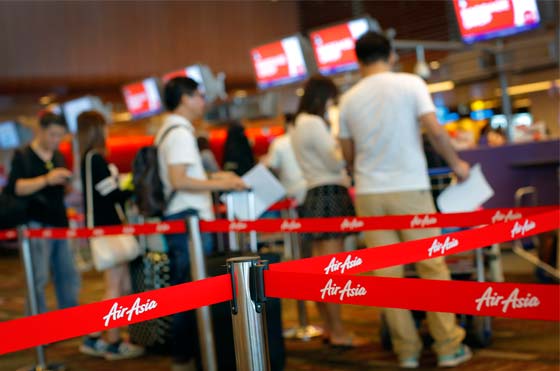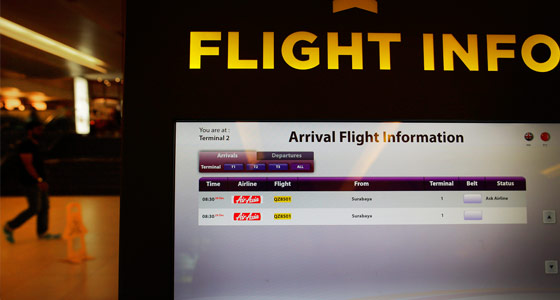
New York: Rescue crews are searching Indonesian waters for AirAsia Indonesia Flight 8501, which disappeared on Sunday with 162 passengers and crew onboard. The plane was flying from Surabaya, Indonesia's second-largest city, and was about halfway to its destination, Singapore, when it vanished from radar.
Q: WHAT COULD HAVE HAPPENED?
A: It is way too early to know for sure, but here are some options. The plane was in the safest part of flight: Just 10 percent of fatal crashes from 2004 through 2013 occurred while a plane was at cruise elevation, according to a safety study published by Boeing in August.
READ MORE: AirAsia flight goes missing, 162 passengers, and crew on board
Passing through bad weather such as severe thunderstorms could have been a factor. Airbus jets have sophisticated computers that automatically adjust to wind shears or other weather disruptions. But weather -- combined with pilot errors -- has played a role in past air disasters that occurred at cruise elevation, including the 2009 Air France Flight 447 crash over the Atlantic Ocean.
Another possibility is some type of catastrophic metal fatigue caused by the cycle of pressurization and depressurization associated with each takeoff and landing cycle. This A320 had had 13,600 takeoffs and landings. Many occurred in humid climate, which speeds corrosion. Still, metal fatigue is unlikely because this plane is only 6 years old.
READ MORE: Search resumes for missing AirAsia passenger jet
Finally, there's the possibility of terrorism or a mass murder by the pilot. There's no evidence of either action, but neither can yet be ruled out.
Q: WHAT DID THE PILOTS SAY TO AIR TRAFFIC CONTROLLERS?
A: The last communication between the pilot and air traffic control was at 6:13 a.m. Sunday (6:13 p.m. EST Saturday) when the pilot "asked to avoid clouds by turning left and going higher to 34,000 feet (10,360 meters)." The last radar contact occurred three minutes later. There was no distress call. But pilots are trained to focus first on the emergency at hand and then communicate only when free.

Q: ISN'T THIS THE THIRD MALAYSIAN JET TO CRASH THIS YEAR?
A: Sort of. Malaysia Airlines Flight 370 disappeared with 239 people aboard soon after takeoff from Kuala Lumpur for Beijing on March 8. Its whereabouts and what happened remain one of the biggest mysteries in commercial aviation. Another Malaysia Airlines flight, also a Boeing 777, was shot down over rebel-controlled eastern Ukraine while en route from Amsterdam to Kuala Lumpur on July 17. All 298 people aboard were killed. AirAsia is also based in Malaysia. But Flight 8501 was operated by AirAsia Indonesia, a subsidiary that's 49 percent owned by the Malaysian parent company. So technically, it's an Indonesian airline. But the AirAsia brand is closely tied to the people of Malaysia.
Q: IS THERE A CONNECTION AMONG ALL THESE CRASHES?
A: No. It's just a very unfortunate year for Southeast Asia. But that doesn't stop conspiracy theories from sprouting. Ideas about what happened to Flight 370 -- both logical and bizarre -- keep appearing. The unsolved nature of that disappearance could generate more attention for Flight 8501 and create a new batch of hypotheses.
Q: HOW FAR COULD THE JET HAVE FLOWN?
A: Looking at the flight's paperwork, the plane had more than 18,000 pounds of jet fuel at takeoff, enough to fly about 3½ hours, according to Phil Derner Jr., the founder of aviation enthusiast website NYCAviation.com and a flight dispatcher for a U.S. airline. He notes that that's less fuel than most flights tend to carry from New York to Florida.
Q: WHAT'S NEXT?
A: Indonesia, Singapore and Malaysia are conducting a search-and-rescue operation near Belitung island in the Java Sea, the plane's last known whereabouts. Assuming that the jet didn't veer far off course, the searchers should find wreckage, which can provide clues about what happened. Investigators will also try to recover the flight data and cockpit voice recorders, which often have the most detailed information about the plane's final moments. Those so-called black boxes have homing beacons that help searchers find them.
Q: IS THE AIRBUS A320 A SAFE JET?
A: The plane is a workhorse of modern aviation. Similar to the Boeing 737, the single-aisle, twin-engine jet is used to connect cities that are between one and five hours apart. Worldwide, 3,606 A320s are in operation, according to Airbus, which also makes nearly identical versions of the plane: The smaller A318 and A319 and the stretched A321. An additional 2,486 of those jets are flying. The A320 family has a good safety record, with just 0.14 fatal accidents per million takeoffs, according to the Boeing safety study.

Q: WHAT ABOUT AIRASIA?
A: Low-cost AirAsia has a strong presence in most of Southeast Asia, and it recently expanded into India. Though most of its flights are just a few hours long, it has tried to expand into long-distance flying through its sister airline AirAsia X. None of its subsidiaries has lost a plane before, and it has a generally good safety record. But it does fly in a part of the world where air travel has expanded faster than the number of qualified pilots, mechanics and air traffic controllers.
Q: WHAT ABOUT FLYING IN INDONESIA?
A: The country has had a bumpy safety record. In 2007, the crash rate and safety standards were so bad that the European Union barred all of Indonesia's airlines from flying into any of its member countries. Than ban was lifted in 2009. But Indonesia's main airline -- fast-growing Lion Air -- is still banned by the EU.
Q: WHAT'S IT LIKE TO FLY THROUGH A THUNDERSTORM AT 34,000 FEET?
A: Planes flying through thunderstorms experience severe turbulence, with the aircraft moving up, down, sideways and rolling. Anything not secured can float around in the cabin, bouncing off things and people. Overhead bins can open up, spilling contents. Airsickness is common.
Q: WHAT DO PILOTS DO TO AVOID THUNDERSTORMS?
A: If at all possible, airline pilots fly around thunderstorms, even if it means going far out of their way. Airliners like the A320 typically are equipped with radar that provides highly accurate weather information. Pilots can see a thunderstorm forming from over 100 miles away, giving them time to plot a way around the storm cluster or to look for gaps to fly through. It's usually not a problem for commercial planes to go 100 or more miles out of the way.
Q: HOW HIGH CAN AN A320 SAFELY FLY? AND WHAT IF IT EXCEEDS THAT LIMIT?
A: The A320 is certified to fly up to 39,000 feet, its maximum altitude before its rate of climb begins to erode. The plane has an absolute flight limit of 42,000 feet. But it can begin to experience problems as low as 37,000 feet, depending on temperature and weight, including fuel, cargo and passengers. The plane's computers should reveal the maximum altitude at which the plane can fly at its current weight and temperature. Planes that exceed their maximum altitude may lose lift, causing an aerodynamic stall. Or they can experience a pressurization blowout, damaging the plane.
Q: HOW DOES A PLANE JUST FALL OFF RADAR?
A: It's still unclear what traffic controllers saw on their screens when the plane disappeared from radar. Authorities haven't said whether they lost only the secondary radar target, which is created by the plane's transponder, or whether the primary radar target, created by energy reflected from the plane, was lost as well. If a plane came apart in the air or suffered a loss of electrical power, the secondary target would be lost, but the primary target is often still visible on radar. But if the plane were descending at rate of over 6,000 feet a minute -- typical of a plane about to crash -- the primary target might be lost as well.

Q: HOW VITAL IS AIR TRAVEL TO THE REGION?
A: For many people, it's the only option. Indonesia is a sprawling archipelago of 250 million people. To get from one island to another, the easiest way is to fly. As the region's economy has grown, so have the number of people flying. The International Air Transport Association recently named Indonesia as one of the world's five fastest-growing air travel markets, predicting an additional 183 million passengers would take to the sky within two decades.
Routes to, from and within the Asia-Pacific region are predicted by the industry trade group to see an extra 1.8 billion annual passengers by 2034, for an overall market size of 2.9 billion. Within two decades, the region is expected to account for 42 percent of global passenger traffic.
The increase in regional airline traffic reflects rapid economic growth. The International Monetary Fund expects the Southeast Asian economies of Indonesia, Malaysia, Philippines, Thailand and Vietnam to grow faster this year and next than anywhere except China, India and sub-Saharan Africa.



















